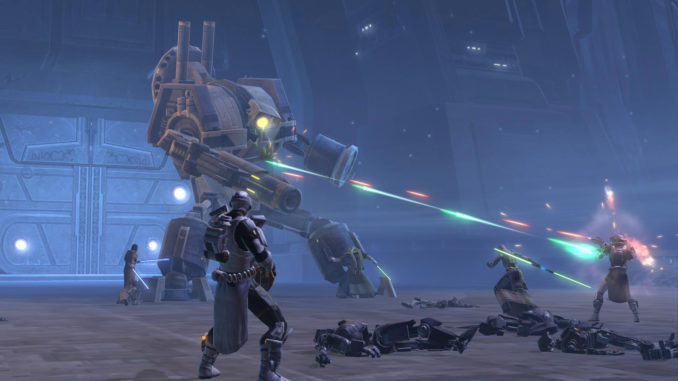
(Author’s Note: Originally published August 3, 2012 for P2R)
A lack of innovation, thin content and an outdated payment model are just some of the problems with BioWare’s MMO. Sean Knight reports
It was a match gamers had hoped for – Star Wars and BioWare coming together again. Only this time, instead of making another RPG like it’s hugely successful Knights of the Old Republic, the Canadian developer delivered the MMO Star Wars: The Old Republic. However, less than a year after its release, SWTOR is struggling with subscription numbers declining at an unpredictable and drastic rate. So much so that BioWare has announced it will now be offering a free-to-play model, set to take effect in October. In the wake of this news, the question many are asking is: what happened to cause the creator of the Mass Effect franchise to finally offer a f2p model?
While BioWare offered a great Star Wars setting, it was hampered by the fact that the game was subscription-based. At a time when dozens of good MMOs are now f2p, to make the pay-to-play model work, SWTOR would have to bring something new to the table. However, when the game arrived, the only innovation was the decision to use voice acting throughout the game rather than a text-based system to tell the story. Some areas, in fact, fell short of expectations.

For instance, SWTOR’s ship combat, which featured on-rails gameplay, was disappointing. Especially when compared to MMOs such as Eve Online and Star Trek: Online, which featured far superior and engaging ship combat. The PvE system was the same as any other MMO, driven by quest systems, just like in World of Warcraft. PvP also follows heavily in the footsteps of a great many other MMOs out there with its interface, controls, and gameplay.
In addition to revisited gameplay and features, SWTOR suffered, like many new MMOs, from a lack of content: or, to be fair, it misjudged how quickly some gamers could go through everything the game had to offer and reach the maximum level cap. It also didn’t help that many MMOs (Lord of the Rings Online, Star Trek: Online, Age of Conan, and others) have spent many years building up a lot of content that could keep gamers entertained and busy for a lot longer.
And, all which offer f2p models.

However, despite launching with a pay-to-play model, the MMO quickly reached 1.7 million subscribers within six weeks of release. A month later, though, the number was down to 1.3 million: a significant drop and a trend that continued as the game recently dipped below 1 million subscribers just eight months after release. While most MMOs experience a subscription drop three to six months after launch, SWTOR’s population decline was sharp and started to happen around the three-month mark.
The decision to stick with a subscription-based model was a poor choice. If SWTOR had been released three to five years ago, this might not have been the case. However, now the MMO market is crowded and almost all of them have similar gameplay and features. Only a few of them have been able to rise above the rest and even then most of the IPs are f2p. What Western developers need to understand is that f2p is the future of the MMO market. People don’t want to be forced to pay a monthly fee.
However, even though SWTOR is set to finally offer a f2p model, the subscription model will still be in effect. It even seems, according to the announcement, that those who pay-to-play will have an advantage over non-paying gamers. This is the wrong move as it could potentially turn SWTOR into a pay-to-win MMO, which isn’t fun for the majority of consumers who are playing for free. If this is the case then here is what will happen when f2p is finally in the picture – BioWare’s MMO will see a rapid increase of players for up to several months only to watch it drop significantly once again.

The purpose of using the f2p model is to increase your subscription numbers in order to maximize the number of players willing to spend money for cosmetic items and other superfluous things. These paying customers tend to make up for the non-paying consumer. The system can work well. For example, LoTRO tripled its revenue when it switched to f2p.
However, SWTOR’s declining numbers aren’t just due to the type of paying/non-paying model used. It also has to do with the fact that almost every MMO, down to its core, is the same as any other. WoW, LoTRO, SWTOR, Age of Conan, Warhammer Online, and the various smaller Western and Asian MMOs all feature quest-based PvE and similar PvP gameplay.
If nothing else, SWTOR’s example is an indication that future MMOs need to evolve and offer something different. Aside from adopting a f2p model, and nothing else, gameplay also needs to change. Quest-based systems and the reliance on forcing players to grind are two of the biggest things that MMOs need to get rid of.
For now, though, SWTOR needs to get rid of the subscription-based model and go fully f2p. Asian MMOs, like Ragnarok Online and MapleStory, have been doing it successfully for years, which is why there are dozens and dozens of variations on these titles, each of which are making money for their respective developers. Western MMOs are finally starting to get the idea as well, albeit more slowly. Subscription-based gaming is already a thing of the past in an age where MMOs are still in their infancy.
(Author’s Note: Support this site, by donating via Paypal or even checking out our merchandise on RedBubble where you can find designs that cater to writers and readers. Money donated or raised goes into paying for this website and equipment.)



